|
NEW LINE
|
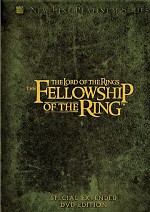
| |
|
MOVIE INFO
|
Director:
Peter Jackson
Cast:
Elijah Wood, Ian McKellen, Viggo Mortensen, Sean Astin, Liv Tyler, Cate Blanchett, John Rhys-Davies, Billy Boyd, Dominic Monaghan, Orlando Bloom, Hugo Weaving, Sean Bean, Ian Holm, Christopher Lee
Screenplay:
Fran Walsh & Philippa Boyens & Peter Jackson, based on the novel by J.R.R. Tolkien
Tagline:
One Ring To Rule Them All.
Box Office:
Budget $109 million.
Opening weekend $66.114 million on 3359 screens.
Domestic gross $313.322 million.
MPAA:
Rated PG-13 for epic battle sequences and some scary images.
Academy Awards:
Won for Best Cinematography; Best Visual Effects; Best Makeup; Best Score-Howard Shore.
Nominated for Best Picture; Best Director; Best Supporting Actor-Ian McKellen; Best Adapted Screenplay; Best Sound; Best Art Direction-Set Decoration; Best Costume Design; Best Editing; Best Song-"May It Be".
| |
|
DVD DETAILS
|
Presentation:
Widescreen 2.35:1/16x9
Audio:
English DD-EX 5.1
English DTS-ES 6.1
English Dolby Surround
Subtitles:
English
Closed-captioned
Runtime: 228 min.
Price: $39.99
Release Date: 11/12/2002
Bonus:
• Audio Commentary with co-writer/co-producer/director Peter Jackson, co-writer/co-producer Fran Walsh, and co-writer Philippa Boyens
• Audio Commentary with production designer Grant Major, costume designer Ngila Dickson, Weta Workshop creative supervisor Richard Taylor, conceptual designers Alan Lee and John Howe, supervising art director/set decorator Dan Hennah, art department manager Chris Hennah, and Weta Workshop manager Tania Rodger
• Audio Commentary with producer Barrie Osborne, executive producer Mark Ordesky, director of photography Andrew Lesnie, editor John Gilbert, co-producer Rick Porras, composer Howard Shore, visual effects supervisor Jim Rygiel, supervising sound editor/co-designer Ethan Van der Ryn, supervising sound editor Mike Hopkins, Weta animation designer and supervisor Randall William Cook, Weta VFX art director Christian Rivers, Weta VFX cinematographer Van’r Hul, and miniature unit director of photography Alex Funke
• Audio Commentary with actors actors Elijah Wood, Ian McKellen, Liv Tyler, Sean Astin, John Rhys-Davies, Billy Boyd, Dominic Monaghan, Orlando Bloom, Christopher Lee, and Sean Bean
• 17 Documentaries: “J.R.R. Tolkien – Creator of Middle-earth”; “From Book to Script”; “Storyboards and Pre-Viz: Making Words into Images”; “Designing Middle-earth”; “Weta Workshop”; “Costume Design”; “The Fellowship of the Cast”; “A Day in the Life of a Hobbit”, “Cameras in Middle-earth”; “Scale”; “Big-atures”; “Weta Digital”; “Editorial: Assembling an Epic”; “Digital Grading”; “The Soundscapes of Middle-earth”; “Music for Middle-earth”; “The Road Goes Ever On...”
• Introductions from Peter Jackson and Elijah Wood
• Early Storyboard Sequence: The Prologue
• Abandoned Storyboard Sequences
• Pre-Viz Animatics
• Storyboard to Film Comparison
• Bag End Set test
• Middle-earth Atlas
• New Zealand as Middle-earth
• “The Peoples of Middle-earth” Galleries
• “The Realms of Middle-earth” Galleries
• Editorial Demonstration: “The Council of Elrond”
• Production Photos
• Stills for Six Miniatures
| |
|
EQUIPMENT
|
Sony 36" WEGA KV-36FS12 Monitor; Sony DA333ES Processor/Receiver; Panasonic CV-50 DVD Player using component outputs; Michael Green Revolution Cinema 6i Speakers (all five); Sony SA-WM40 Subwoofer.
| |
[an error occurred while processing this directive]
|
The Lord of the Rings: The Fellowship of the Ring - Platinum Series Extended Edition (2001)
|
|
Reviewed by Colin Jacobson
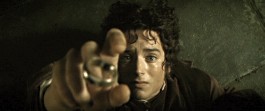 If someone asked me at the end of 2001 which directors I thought best supported DVD, my stock answer would have been David Fincher and Michael Bay. From packages like Fincher’s Fight Club and Se7en to the solid Criterion editions of Bay’s The Rock and Armageddon, these two established an excellent DVD track record.
If someone asked me at the end of 2001 which directors I thought best supported DVD, my stock answer would have been David Fincher and Michael Bay. From packages like Fincher’s Fight Club and Se7en to the solid Criterion editions of Bay’s The Rock and Armageddon, these two established an excellent DVD track record.
In 2002, however, Bay clearly took the lead. We got a stunning four-DVD release of his Pearl Harbor that put almost other packages to shame. Fincher, on the other hand, let Sony put out a virtually supplements-free version of Panic Room. I’ve heard that eventually a packed special edition of Panic Room will appear, but nothing concrete has emerged as of early November 2002, so those thoughts remain in the “rumor” category.
Also in 2002, another aspirant for the crown of Best Director for DVD emerged: Peter Jackson. He won’t take the trophy simply because his track record doesn’t rival Bay’s. However, with the release of this special edition of The Lord of the Rings: The Fellowship of the Ring, Jackson certainly sets himself up as one of the DVD format’s best supporters.
Although Bay has so far released two movies in the period since the March 1997 launch of DVD, Fellowship marked Jackson’ first flick in that time. Actually, we hadn’t heard a peep from Jackson since August 1996’s The Frighteners; he went more than five years without a movie.
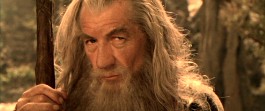 But he didn’t remain inactive during that period. He spent much of the period working on Fellowship and in November 1998, we got a four-laserdisc release of Frighteners. Possibly the most thorough laserdisc ever made, that package added a little footage back into the flick and also provided an audio commentary and many other extras. Most significant in the latter category was the roughly four-hour documentary Jackson assembled for the piece.
But he didn’t remain inactive during that period. He spent much of the period working on Fellowship and in November 1998, we got a four-laserdisc release of Frighteners. Possibly the most thorough laserdisc ever made, that package added a little footage back into the flick and also provided an audio commentary and many other extras. Most significant in the latter category was the roughly four-hour documentary Jackson assembled for the piece.
Universal never bothered to release that Frighteners package on DVD. Since studios now apparently feel no reluctance to put out two, three or even four disc sets, it seems hard to recall, but back in the fall of 1998, even double-DVD releases rarely occurred. I don’t think Universal had created any as of that point, and I guess they felt Frighteners didn’t merit such treatment.
I owned the four-LD Frighteners. It was never my favorite LD set, mainly because I liked the movie but didn’t think it offered anything great. However, it did stand as one of the finest LD packages ever created.
Now the SE for Fellowship will stake its claim as arguably the strongest DVD release of all-time. I’ll discuss the supplements in the appropriate area of this review, but here I’ll chat a little about the movie itself. For full coverage of my thoughts about Fellowship, please check out my review of the theatrical version. For this article, I’ll stick mostly with the differences evident in the SE’s extended cut of the film.
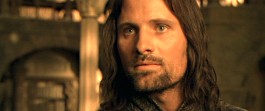 As I noted in my prior review, I enjoyed the original version of Fellowship but it didn’t dazzle me. However, I must note that I’ve now seen the movie three times and I’ve liked it more after each successive screening. The flick withstands repeated viewings quite well as it reveals additional charms with additional scrutiny. Really, the world of Tolkien seems so dense and complicated that for someone with little background in that universe, it can be somewhat inaccessible. That’d be someone like me, as I never read the books or saw any of the prior film adaptations. As I rewatched Fellowship, I felt better equipped to enjoy its nuances since I became more comfortable with its myriad number of characters and settings.
As I noted in my prior review, I enjoyed the original version of Fellowship but it didn’t dazzle me. However, I must note that I’ve now seen the movie three times and I’ve liked it more after each successive screening. The flick withstands repeated viewings quite well as it reveals additional charms with additional scrutiny. Really, the world of Tolkien seems so dense and complicated that for someone with little background in that universe, it can be somewhat inaccessible. That’d be someone like me, as I never read the books or saw any of the prior film adaptations. As I rewatched Fellowship, I felt better equipped to enjoy its nuances since I became more comfortable with its myriad number of characters and settings.
So while I still don’t possess extraordinary enthusiasm for Fellowship, I better appreciate its charms now than I did when I first saw it 10 months ago, and I’ve come to really like it a lot. Already a long movie, the “extended edition” adds about half an hour to the flick. Fellowship now runs about 208 minutes versus the original’s 178 minutes. Actually, the entire program lasts 228 minutes, but the final 20 minutes display “Special thanks to the charter members of the LOTR official fan club”. With about 27 minutes of total text, this edition of Fellowship must include the longest credit roll in history!
While the original DVD packed the entire feature onto one DVD, the extended version spreads the film across two platters. The first one runs 1:45:30 and cuts at a very appropriate point right after the formation of the fellowship. The second disc offers programming that lasts 2:02:20 if we include the lengthy fan club credits. In a nice touch, when you start DVD Two, it offers a menu that lets you either go right back into the movie or allows you to choose one of the four audio commentaries. Some may see this as a distraction since the film doesn’t simply continue without input from the viewer, but given the myriad of auditory choices, I like the fact the DVD’s producers don’t just assume what version you’ll prefer.
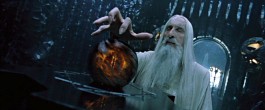 As for the actual film footage, this material integrates quite well into the action. I recognized some of the added scenes but not all of them; after two screenings, I guess I didn’t know the flick well enough to immediately detect every change. Many of the extended sequences seemed pretty modest in nature. Rather than add a few long bits, this version of Fellowship mostly featured a lot of smaller extensions.
As for the actual film footage, this material integrates quite well into the action. I recognized some of the added scenes but not all of them; after two screenings, I guess I didn’t know the flick well enough to immediately detect every change. Many of the extended sequences seemed pretty modest in nature. Rather than add a few long bits, this version of Fellowship mostly featured a lot of smaller extensions.
I liked that approach, for it supplemented the original film but didn’t alter its flow. To my eyes, the most substantial change occurred at the start of the movie, as it offered a longer introduction to Hobbiton. While not necessary to establish the characters and the setting, I enjoyed this sequence. It nicely set up that realm and provided a nice backdrop for the flick’s opening.
Overall, I felt that the additions didn’t substantially change the movie. They fleshed out sequences and characters well but they didn’t provide any extreme variations. Unlike something such as The Abyss, the extra material didn’t alter the story or our interpretation of things. I viewed the new material as icing on the cake. The film works well in its theatrical cut, but these extended pieces make it just a little bit more satisfying.
One nice touch: if you check out the chapter menus on DVDs One and Two, you’ll find notations that indicate which ones include either new or extended scenes. This provides a helpful notation for those of us who feel less than secure in our knowledge of the material.
|
The DVD Grades: Picture A- / Audio A- / Bonus A+
|
|
 The Lord of the Rings: The Fellowship of the Ring appears in an aspect ratio of approximately 2.35:1 on these single-sided, dual-layered DVDs; the image has been enhanced for 16X9 televisions. Overall, the picture seemed solid, with very few flaws on display.
The Lord of the Rings: The Fellowship of the Ring appears in an aspect ratio of approximately 2.35:1 on these single-sided, dual-layered DVDs; the image has been enhanced for 16X9 televisions. Overall, the picture seemed solid, with very few flaws on display.
Sharpness appeared excellent. The movie always remained nicely crisp and distinct, and I noticed virtually no instances of softness or fuzziness. Jagged edges and moiré effects created no concerns, and I also detected no signs of edge enhancement. As for print flaws, the movie showed a wee smidgen of grain at times, but this remained very minor. Most of these small issues occurred during the scenes in Hobbiton; those displayed the film’s weakest elements, though they still remained generally positive. Otherwise, the image seemed free of any form of defects.
Fellowship enjoyed a stylized palette that varied dependent on the location. For example, when we entered elf territory, the film adopted a heavily golden tone, and other climates might strongly desaturate the image. The colors always remained nicely vivid and vibrant, and they showed no problems related to bleeding, noise, or other concerns, even when we entered some red-dominated areas. Black levels came across as deep and dense, while shadow detail was appropriately heavy but not overly thick. Ultimately, the image of Fellowship looked pretty terrific.
The extended edition of Fellowship integrated the new half hour of scenes neatly, and I never noticed any disruptive or awkward edits. The visuals appeared consistently positive for those segments, so I didn’t detect any decrease in quality. When I compared the extended edition with the original theatrical cut DVD, I didn’t witness any variations. Both showed very similar images and seemed equally positive.
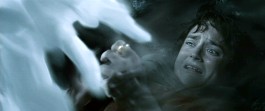 I also felt pleased with the Dolby Digital EX 5.1 and DTS ES 6.1 soundtracks of Fellowship, though I admit the audio didn’t overwhelm me to the degree apparently experienced by others. I’ve read massive praise for the mixes that I didn’t think they merited. Actually, the audio did overwhelm me, which was the problem. Bass levels went off the chart during much of the film, and I don’t feel that more is necessarily better. Fellowship poured on the low-end to an excessive degree, and it became a distraction at times. It seemed like every little noise pounded my subwoofer into submission, and this felt over the top and unnecessary. Some may love this emphasis on heavy bass, but it dissatisfied me to a small degree.
I also felt pleased with the Dolby Digital EX 5.1 and DTS ES 6.1 soundtracks of Fellowship, though I admit the audio didn’t overwhelm me to the degree apparently experienced by others. I’ve read massive praise for the mixes that I didn’t think they merited. Actually, the audio did overwhelm me, which was the problem. Bass levels went off the chart during much of the film, and I don’t feel that more is necessarily better. Fellowship poured on the low-end to an excessive degree, and it became a distraction at times. It seemed like every little noise pounded my subwoofer into submission, and this felt over the top and unnecessary. Some may love this emphasis on heavy bass, but it dissatisfied me to a small degree.
Otherwise, Fellowship provided a very solid auditory experience. The soundfield offered a very wide and engaging piece. All five channels received active usage throughout the film, and they created a nicely vivid and life-like environment. Music showed fine stereo presence, while effects appeared from all around the spectrum. Those elements blended together neatly, and they moved cleanly from speaker to speaker. Surround usage was effective and accurate without becoming overwhelming or gimmicky. None of the film’s scenes stood out to me as anything particularly noteworthy, but the package mixed together to become a fine and seamless whole.
Except for the heavy bass, audio quality seemed strong. Dialogue sounded natural and crisp, and I noticed no problems related to edginess or intelligibility. Music was bright and vibrant and displayed positive range; the excessive low-end became an issue only in regard to effects. Other than that factor, those elements appeared clean and distinct, and they lacked any signs of distortion. The overwhelming bass almost caused me to knock my grade down to a “B+”, but I felt the overall audio of Fellowship worked well enough to merit an “A-“.
 For the most part, I felt the Dolby Digital and DTS tracks sounded almost identical. The main difference I noticed related to bass response. Though it remained marginally overwhelming, low-end material sounded tighter and less disruptive during the DTS version. I still thought bass remained too heavy, but it showed some improvements. The two tracks seemed a lot alike, but I preferred the DTS mix by a hair.
For the most part, I felt the Dolby Digital and DTS tracks sounded almost identical. The main difference I noticed related to bass response. Though it remained marginally overwhelming, low-end material sounded tighter and less disruptive during the DTS version. I still thought bass remained too heavy, but it showed some improvements. The two tracks seemed a lot alike, but I preferred the DTS mix by a hair.
For this four-DVD release of Fellowship, we find tons of extras. On the first two discs, we locate a whopping four audio commentaries. Called The Director and Writers, the first logically comes from director/co-writer/producer Peter Jackson, co-writer/producer Fran Walsh, and co-writer Philippa Boyens, all of whom sat together for this running, screen-specific affair. And a good one it is, as the participants offer a light and lively discussion of the film. They cover a terrific variety of topics. We learn about the additions made for the extended edition of the film as well as working with the cast, changes from the Tolkien book, effects, location and set challenges, plus many other areas. Jackson dominates but both women offer some good notes as well, and they cumulatively prove to be very chatty. Despite the very long running time of the feature, almost no empty spots appear during this entertaining and compelling piece. I never thought I’d listen to a three-and-a-half hour commentary that left me eager for more, but this fun track kept me constantly interested and engrossed.
Next we find a Design Team track that includes remarks from production designer Grant Major, costume designer Ngila Dickson, Weta Workshop creative supervisor Richard Taylor, conceptual designers Alan Lee and John Howe, supervising art director/set decorator Dan Hennah, art department manager Chris Hennah, and Weta Workshop manager Tania Rodger. It appeared that most of the participants sat on their own for this edited piece, but the Hennahs clearly were recorded together. If you listen to this track, you’ll learn about all things visual in regard to Fellowship. The program covers props, sets, costumes, makeup and pretty much everything else under that falls under that umbrella.
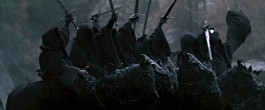 Though this might seem dry, the commentary actually comes across as nicely lively and engaging. The pace moves quickly and provides lots of cool details about the material, with many fun anecdotes along the way. Want to know how they tried to keep the Hobbit actors feet warm? Listen here. Want to know about a controversy related to arcane languages? Here you go!
Though this might seem dry, the commentary actually comes across as nicely lively and engaging. The pace moves quickly and provides lots of cool details about the material, with many fun anecdotes along the way. Want to know how they tried to keep the Hobbit actors feet warm? Listen here. Want to know about a controversy related to arcane languages? Here you go!
I liked the fact it offered so many notes about the visual design rather than simply “nuts and bolts” issues. For example, we learn about the stylistic concerns related to the computer created characters but we don’t hear about the technical areas; that’ll follow in the next commentary. Many tracks of this sort can drag due to excessive jargon and procedural matters, but this one goes by briskly since it avoids those traps. It offers a great look at the ways the crew brought Middle-earth to life, and it manages to provide a fun and entertaining glimpse at the design issues.
For the third commentary, we find a discussion from the Production/Post-Production Team. This program includes remarks from producer Barrie Osborne, executive producer Mark Ordesky, director of photography Andrew Lesnie, editor John Gilbert, co-producer Rick Porras, composer Howard Shore, visual effects supervisor Jim Rygiel, supervising sound editor/co-designer Ethan Van der Ryn, supervising sound editor Mike Hopkins, Weta animation designer and supervisor Randy Cook, Weta VFX art director Christian Rivers, Weta VFS cinematographer Van’r Hul, and miniature unit director of photography Alex Funke. Many of these folks obviously sat together, and it appeared they clustered in logical teams. The results then were edited together to make this track.
While the production/post-production commentary seems like the least interesting of Fellowship’s four pieces, it still gives us a good look at the film. It covers a mix of issues not discussed elsewhere. We hear a little about casting as well as lighting and other photographic issues, sound effects, computer and other visual material, the score, editorial decisions, and a few additional subjects. As always, the pace remains brisk and lively, and the commentary includes virtually no dead space. Some minor redundancies occur when we get more notes about the scenes reinstated for the extended cut of the film, but even those happen infrequently. Overall, this commentary adds a lot to one’s knowledge of Fellowship.
 Lastly, we find a Cast commentary that provides material from actors Elijah Wood, Ian McKellen, Liv Tyler, Sean Astin, John Rhys-Davies, Billy Boyd, Dominic Monaghan, Orlando Bloom, Christopher Lee, and Sean Bean. The four hobbits clearly sat together for their pieces, but it appeared that the others were taped separately. Not surprisingly, that means that the four hobbits dominate this lively little track.
Lastly, we find a Cast commentary that provides material from actors Elijah Wood, Ian McKellen, Liv Tyler, Sean Astin, John Rhys-Davies, Billy Boyd, Dominic Monaghan, Orlando Bloom, Christopher Lee, and Sean Bean. The four hobbits clearly sat together for their pieces, but it appeared that the others were taped separately. Not surprisingly, that means that the four hobbits dominate this lively little track.
Of the four commentaries, the cast program probably offers the lowest level of concrete information about Fellowship, but it still presents a good deal of data, and it seems like a lot of fun. The hobbits spend too much time talking about how great everything and everyone is, but they interact well together and toss out lots of entertaining anecdotes from the set. The remarks from the others lack the same level of energy, but they compensate via more substantial notes about the film. McKellen and Tyler seem especially useful in that regard, as they provide many compelling statements about their experiences and how they achieved their work. Rhys-Davies also adds some great insight and anecdotes. The cast track finishes this run of commentaries on a pleasurable and satisfying note.
With the end of the fourth commentary, we finish with the first two DVDs, but I want to make one remark before I progress. I don’t skim through portions of DVDs when I review them, which meant I needed to sit through all 14 hours of commentaries to write this article. I can’t say I looked forward to that task, simply because it would be so incredibly time consuming. However, these tracks all seemed so good that I didn’t mind the time at all.
Admittedly, I love audio commentaries, but the prospect of 14 hours worth of Fellowship data sounded wearying. Pleasantly, the tracks went by quickly and I enjoyed the entire process. This DVD set of Fellowship didn’t just pack in four commentaries for bragging rights. Each one seems compelling and entertaining in its own right. Clearly a lot of care and thought went into the creation of the various tracks, which helped make this package all the more useful.
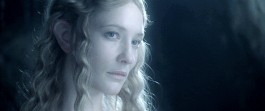 One cool aspect of the commentaries: on-screen text identifies each speaker every time a new one appears. This means that the Fellowship tracks lack the constant voice-overs otherwise necessary to remind us of the different participants. This makes it easier to follow the commentary and seems like a thoughtful addition, especially during the tracks with many different members.
Discs One and Two also include a couple of Easter eggs. On DVD One, go to the final page of the “Select a Scene” area and highlight chapter 27. Click down from there and you’ll see a ring. Hit “enter” and you’ll get a three-minute, 29-second spoof from the MTV Movie Awards that features Sarah Michelle Gellar and Jack Black.
One cool aspect of the commentaries: on-screen text identifies each speaker every time a new one appears. This means that the Fellowship tracks lack the constant voice-overs otherwise necessary to remind us of the different participants. This makes it easier to follow the commentary and seems like a thoughtful addition, especially during the tracks with many different members.
Discs One and Two also include a couple of Easter eggs. On DVD One, go to the final page of the “Select a Scene” area and highlight chapter 27. Click down from there and you’ll see a ring. Hit “enter” and you’ll get a three-minute, 29-second spoof from the MTV Movie Awards that features Sarah Michelle Gellar and Jack Black.
For something a little less distasteful, head to the egg on DVD Two. Enter its “Select a Scene” area and click chapter 48 on the right side of the screen. Once you do this, move the icon down to highlight a two towers icon. Click “enter” and you’ll find the original Two Towers preview trailer that appeared toward the end of Fellowship’s theatrical run.
Continue to Disc 3 & 4
|
|
Viewer Film Ratings: 4.5673 Stars | Number of Votes: 386 |
|
|

